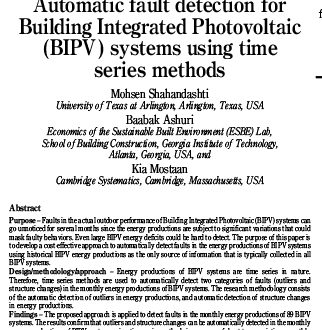Purpose– Faults in the actual outdoor performance of Building Integrated Photovoltaic (BIPV) systems can go unnoticed for several months since the energy productions are subject to significant variations that could mask faulty behaviors. Even large BIPV energy deficits could be hard to detect. The purpose of this paper is to develop a cost-effective approach to automatically detect faults in the energy productions of BIPV systems using historical BIPV energy productions as the only source of information that is typically collected in all BIPV systems.
Design methodology approach– Energy productions of BIPV systems are time series in nature. Therefore. time series methods are used to automatically detect two categories of faults (outliers and structure changes) in the monthly energy productions of BIPV systems. The research methodology consists of the automatic detection of outliers in energy productions. and automatic detection of structure changes in energy productions.
Findings– The proposed approach is applied to detect faults in the monthly energy productions of 89 BIPV systems. The results confirm that outliers and structure changes can be automatically detected in the monthly energy productions of BIPV systems using time series methods in presence of short-term variations. monthly seasonality. and long-term degradation in performance.
Originality value– Unlike existing methods. the proposed approach does not require performance ratio calculation. operating condition data. such as solar irradiation. or the output of neighboring BIPV systems. It only uses the historical information about the BIPV energy productions to distinguish between faults and other time series properties including seasonality. short-term variations. and degradation trends.
 Iran Energy News Oil, Gas, Petrochemical and Energy Field Specialized Channel
Iran Energy News Oil, Gas, Petrochemical and Energy Field Specialized Channel




